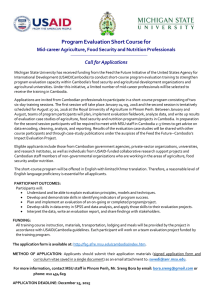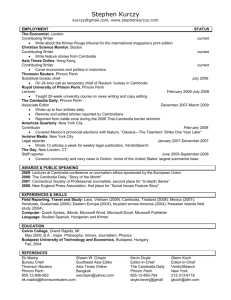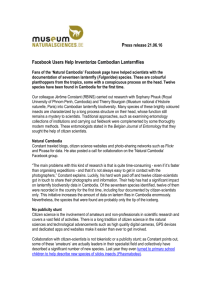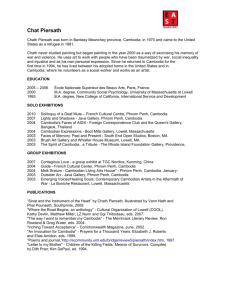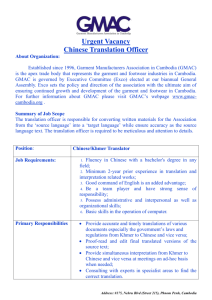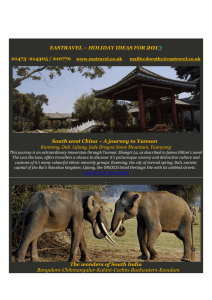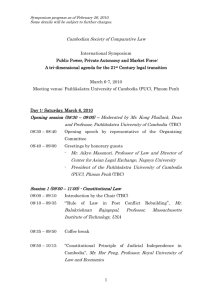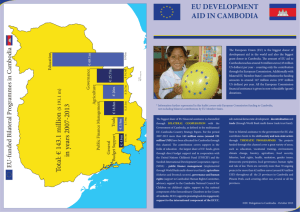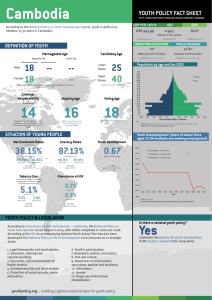Emergency Medicine in Cambodia
advertisement
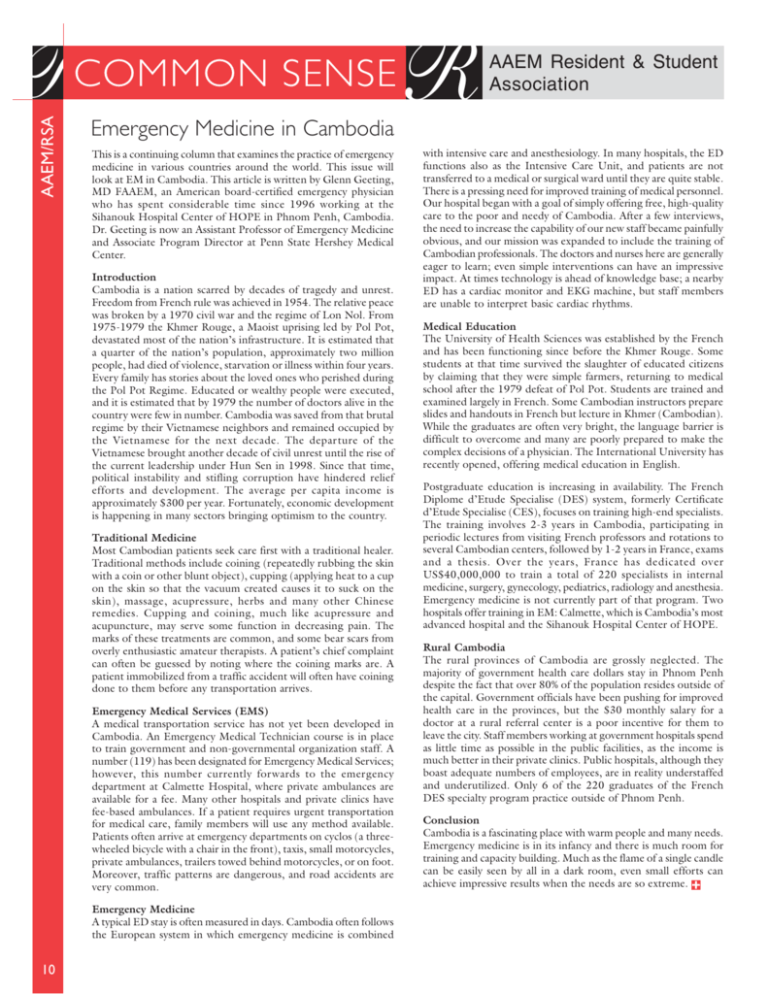
AAEM/RSA RCOMMON SENSE R Emergency Medicine in Cambodia This is a continuing column that examines the practice of emergency medicine in various countries around the world. This issue will look at EM in Cambodia. This article is written by Glenn Geeting, MD FAAEM, an American board-certified emergency physician who has spent considerable time since 1996 working at the Sihanouk Hospital Center of HOPE in Phnom Penh, Cambodia. Dr. Geeting is now an Assistant Professor of Emergency Medicine and Associate Program Director at Penn State Hershey Medical Center. Introduction Cambodia is a nation scarred by decades of tragedy and unrest. Freedom from French rule was achieved in 1954. The relative peace was broken by a 1970 civil war and the regime of Lon Nol. From 1975-1979 the Khmer Rouge, a Maoist uprising led by Pol Pot, devastated most of the nation’s infrastructure. It is estimated that a quarter of the nation’s population, approximately two million people, had died of violence, starvation or illness within four years. Every family has stories about the loved ones who perished during the Pol Pot Regime. Educated or wealthy people were executed, and it is estimated that by 1979 the number of doctors alive in the country were few in number. Cambodia was saved from that brutal regime by their Vietnamese neighbors and remained occupied by the Vietnamese for the next decade. The departure of the Vietnamese brought another decade of civil unrest until the rise of the current leadership under Hun Sen in 1998. Since that time, political instability and stifling corruption have hindered relief efforts and development. The average per capita income is approximately $300 per year. Fortunately, economic development is happening in many sectors bringing optimism to the country. Traditional Medicine Most Cambodian patients seek care first with a traditional healer. Traditional methods include coining (repeatedly rubbing the skin with a coin or other blunt object), cupping (applying heat to a cup on the skin so that the vacuum created causes it to suck on the skin), massage, acupressure, herbs and many other Chinese remedies. Cupping and coining, much like acupressure and acupuncture, may serve some function in decreasing pain. The marks of these treatments are common, and some bear scars from overly enthusiastic amateur therapists. A patient’s chief complaint can often be guessed by noting where the coining marks are. A patient immobilized from a traffic accident will often have coining done to them before any transportation arrives. Emergency Medical Services (EMS) A medical transportation service has not yet been developed in Cambodia. An Emergency Medical Technician course is in place to train government and non-governmental organization staff. A number (119) has been designated for Emergency Medical Services; however, this number currently forwards to the emergency department at Calmette Hospital, where private ambulances are available for a fee. Many other hospitals and private clinics have fee-based ambulances. If a patient requires urgent transportation for medical care, family members will use any method available. Patients often arrive at emergency departments on cyclos (a threewheeled bicycle with a chair in the front), taxis, small motorcycles, private ambulances, trailers towed behind motorcycles, or on foot. Moreover, traffic patterns are dangerous, and road accidents are very common. Emergency Medicine A typical ED stay is often measured in days. Cambodia often follows the European system in which emergency medicine is combined 10 AAEM Resident & Student Association with intensive care and anesthesiology. In many hospitals, the ED functions also as the Intensive Care Unit, and patients are not transferred to a medical or surgical ward until they are quite stable. There is a pressing need for improved training of medical personnel. Our hospital began with a goal of simply offering free, high-quality care to the poor and needy of Cambodia. After a few interviews, the need to increase the capability of our new staff became painfully obvious, and our mission was expanded to include the training of Cambodian professionals. The doctors and nurses here are generally eager to learn; even simple interventions can have an impressive impact. At times technology is ahead of knowledge base; a nearby ED has a cardiac monitor and EKG machine, but staff members are unable to interpret basic cardiac rhythms. Medical Education The University of Health Sciences was established by the French and has been functioning since before the Khmer Rouge. Some students at that time survived the slaughter of educated citizens by claiming that they were simple farmers, returning to medical school after the 1979 defeat of Pol Pot. Students are trained and examined largely in French. Some Cambodian instructors prepare slides and handouts in French but lecture in Khmer (Cambodian). While the graduates are often very bright, the language barrier is difficult to overcome and many are poorly prepared to make the complex decisions of a physician. The International University has recently opened, offering medical education in English. Postgraduate education is increasing in availability. The French Diplome d’Etude Specialise (DES) system, formerly Certificate d’Etude Specialise (CES), focuses on training high-end specialists. The training involves 2-3 years in Cambodia, participating in periodic lectures from visiting French professors and rotations to several Cambodian centers, followed by 1-2 years in France, exams and a thesis. Over the years, France has dedicated over US$40,000,000 to train a total of 220 specialists in internal medicine, surgery, gynecology, pediatrics, radiology and anesthesia. Emergency medicine is not currently part of that program. Two hospitals offer training in EM: Calmette, which is Cambodia’s most advanced hospital and the Sihanouk Hospital Center of HOPE. Rural Cambodia The rural provinces of Cambodia are grossly neglected. The majority of government health care dollars stay in Phnom Penh despite the fact that over 80% of the population resides outside of the capital. Government officials have been pushing for improved health care in the provinces, but the $30 monthly salary for a doctor at a rural referral center is a poor incentive for them to leave the city. Staff members working at government hospitals spend as little time as possible in the public facilities, as the income is much better in their private clinics. Public hospitals, although they boast adequate numbers of employees, are in reality understaffed and underutilized. Only 6 of the 220 graduates of the French DES specialty program practice outside of Phnom Penh. Conclusion Cambodia is a fascinating place with warm people and many needs. Emergency medicine is in its infancy and there is much room for training and capacity building. Much as the flame of a single candle can be easily seen by all in a dark room, even small efforts can achieve impressive results when the needs are so extreme.
![Cambodian New Year - Rotha Chao [[.efolio.]]](http://s2.studylib.net/store/data/005298862_1-07ad9f61287c09b0b20401422ff2087a-300x300.png)
